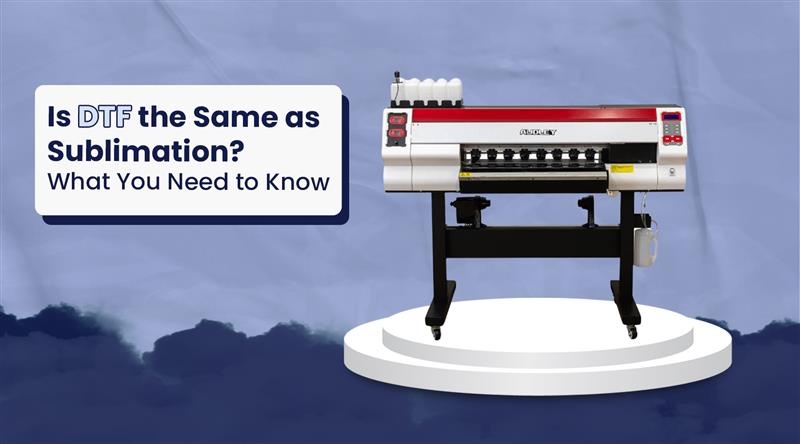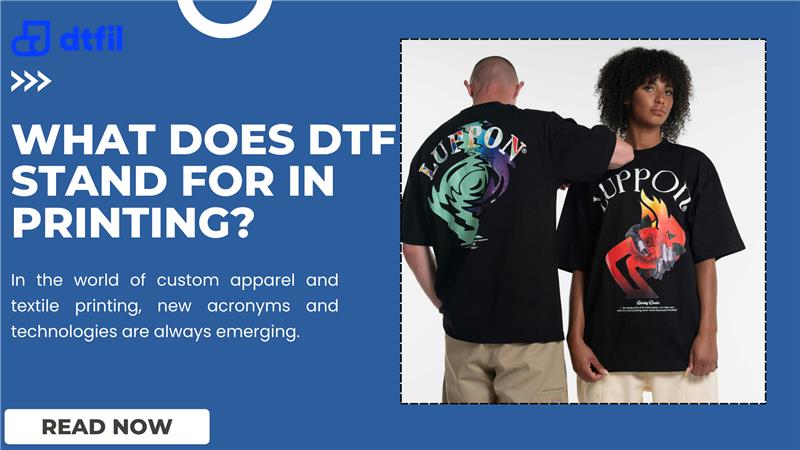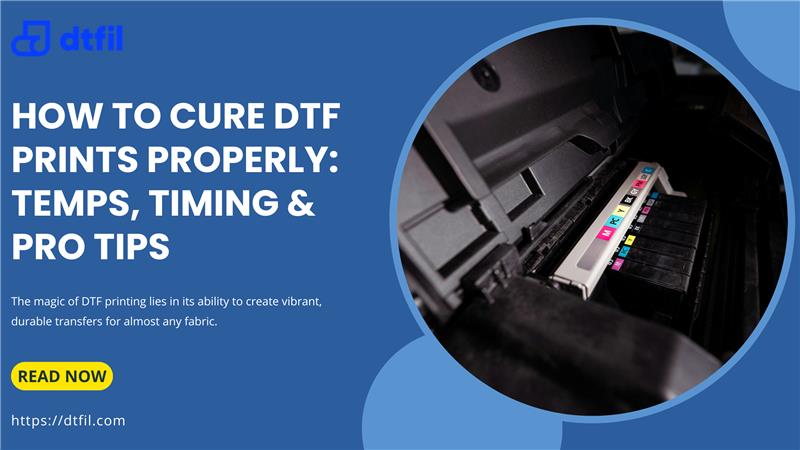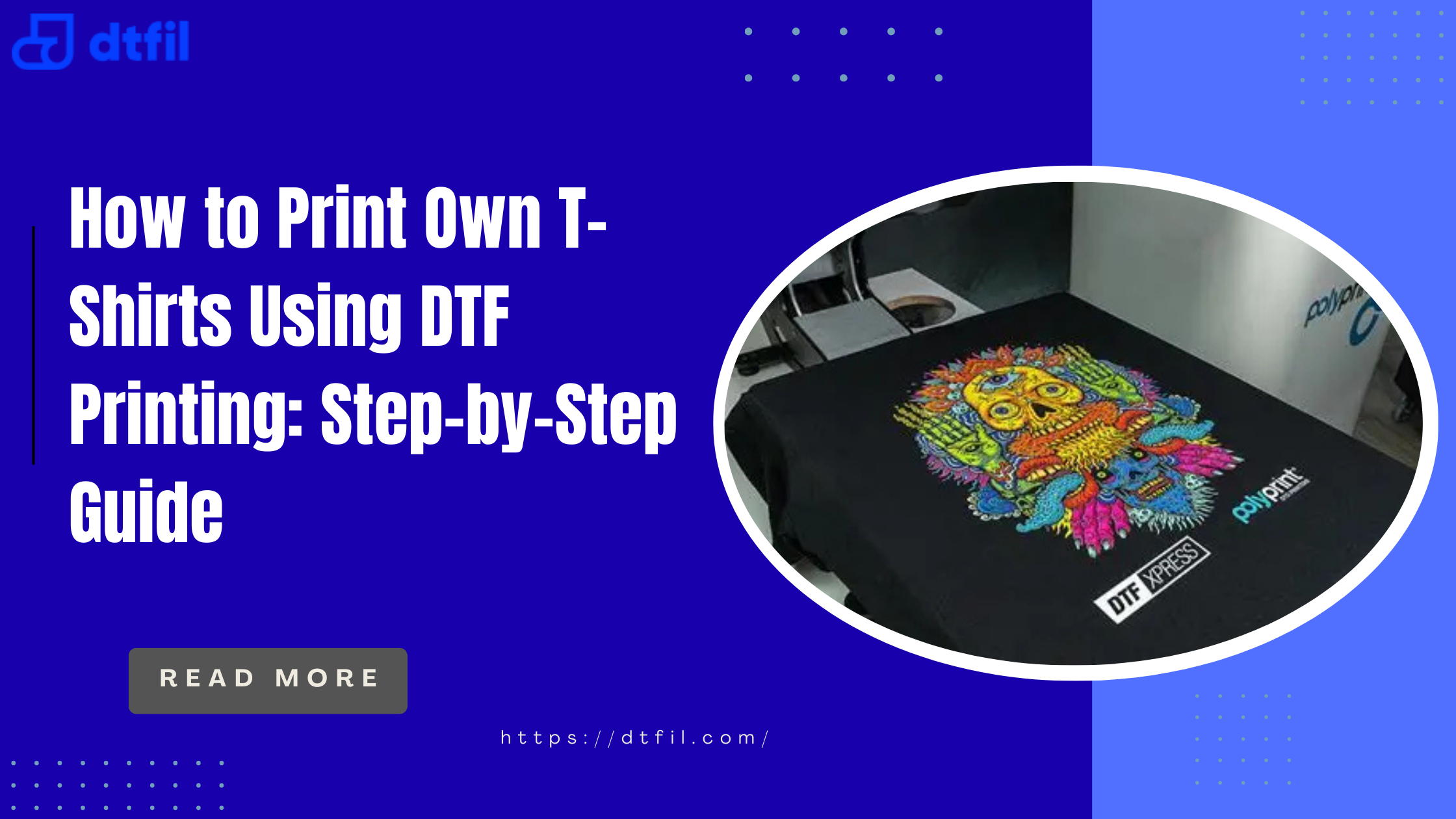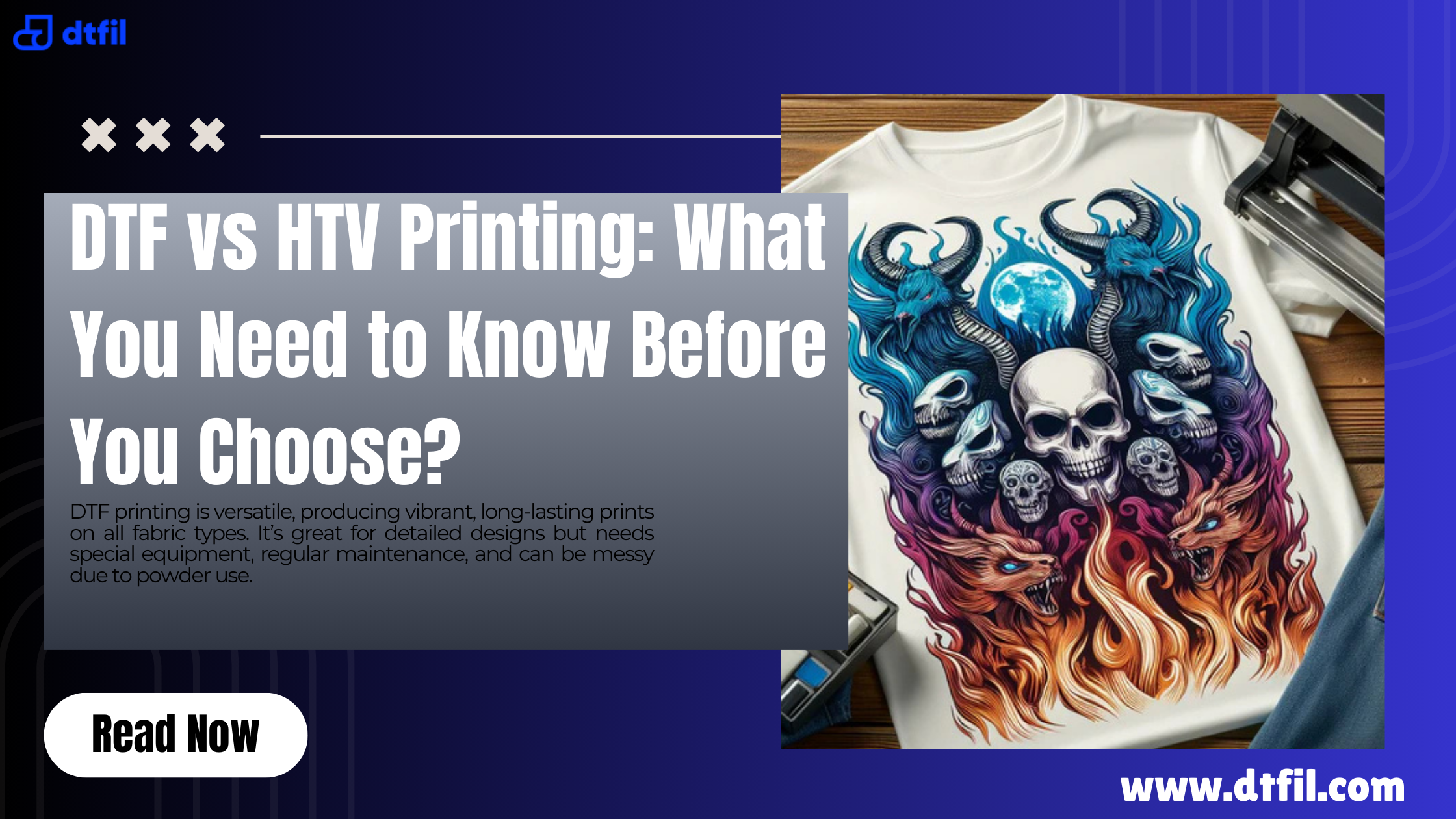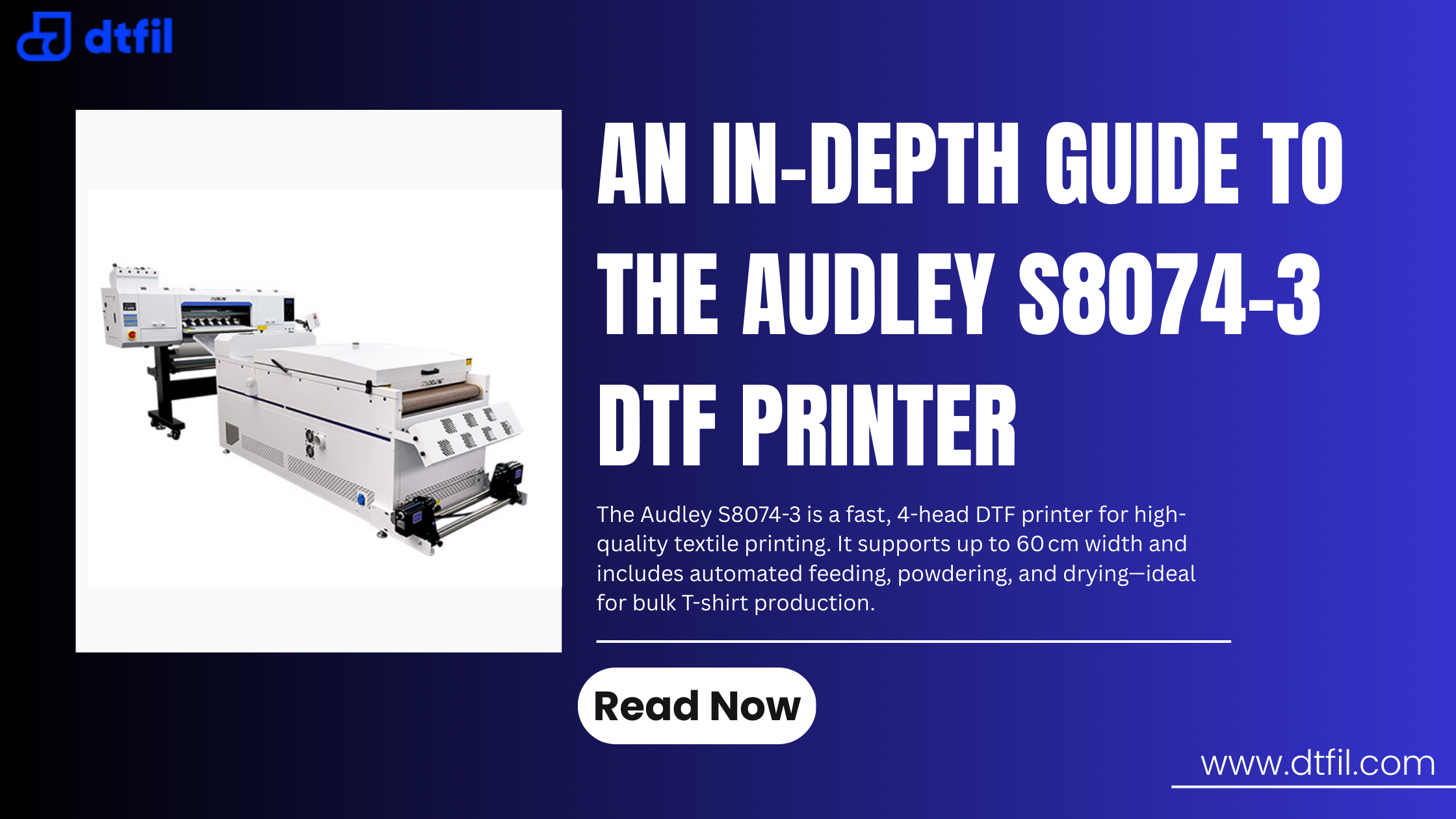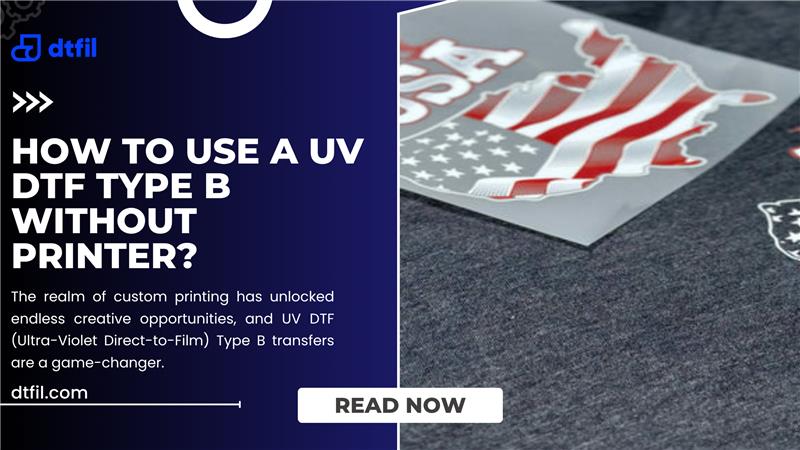When you visit craft stores, you’re likely to come across shelves and displays filled with eye-catching products like T-shirts, tote bags, and mugs featuring vibrant, intricate prints. These products are beyond any doubt appealing and often make you want to bring one home. But have you ever stopped to wonder how those stunning, detailed designs are created? The answer lies in popular printing techniques like DTF and sublimation.
Although they might seem similar at first glance, they represent distinct processes, each with its own unique approach and purpose. So, are DTF and sublimation interchangeable terms, or do they represent different printing methods? Is DTF the same as sublimation?
Keep reading as we break down the differences by exploring DTF printing vs sublimation, comparing DTF ink vs. sublimation ink, and many more.
Understanding DTF Printing and Sublimation

What is DTF Printing?
DTF or Direct to Film, a method involves using environmentally friendly, water-based ink to print patterns onto a specially coated film. In order to enable the ink to stick to the cloth when heat-pressed, the design is subsequently covered with a layer of adhesive powder and allowed to dry.
DTF transfer films are a top choice in the printing and apparel industry due to their ability to produce vibrant, durable, photorealistic designs with unique patterns, setting them apart from traditional printing methods.
What is Sublimation?
An advanced printing technology that uses heat-sensitive ink to produce vibrant, long-lasting colors is a well-known sublimation method. These colors become embedded into the fabric, making them resistant to cracking and fading over time.
In the heat sublimation printing process, the ink transforms directly from a solid to a gas without passing through a liquid state. This unique process allows the ink to bond seamlessly with the fabric's fibers, creating an image that becomes a part of the material.
Also Read: What is a Gang Sheet for DTF? How to Save Time and Money
Is DTF the Same as Sublimation? Difference and Similarities Between DTF and Sublimation

When comparing sublimation vs DTF, it’s important to understand their key differences and similarities. If you’re wondering, is DTF sublimation?The answer lies in their processes and applications. These two printing methods share the following traits in common:
- Customization: Both methods enable intricate, unique, and superior designs.
- Heat Transfer Needed: In both procedures, designs are transferred from a medium to cloth using heat.
- Effectiveness: Both techniques can result in designs that endure for years with the right maintenance.
DTF vs Sublimation
Quality of Printing
DTF transfers can print onto almost all types of fabrics, including dark and light-colored items, cotton, polyester, and blends. Whereas sublimation printing is limited to light-colored or white polyester fabrics, as it requires a high percentage of synthetic fibers to bond with.
Heat Transfer Process
DTF printing uses an adhesive to attach the design to the fabric.It Involves transfer paper to transfer the image into the fabric or material. And in sublimation printing, it bonds the inks to the fabric through heat and does not use adhesive powder.
Fabric Compatibility
DTF printing can be used on various types of fabrics, including cotton, polyester, and blends and suitable for dark-colored fabrics, as well as light-colored ones. While sublimation printing is limited to synthetic materials and requires white or very light-colored fabrics to achieve optimal results.
Setup costs
Talking about the initial cost of DTF printing, it requires a specialized printer and heat press, increasing initial investment. In contrast, sublimation printing also requires a specialized printer and heat press, but can be more cost-effective for large-scale productions.
Color Brightness
DTF Printing offers more vibrant colors due to the ink being laid down on top of the fabric.
On the other hand in sublimation printing colors are not as vivid, as the ink bonds with the fabric at a molecular level.
Also Read: What is a DTF Printer? Exploring Features and Benefits
Pros and Cons of DTF and Sublimation Printing
Since both sublimation printing and DTF printing are widely used methods, each has advantages and disadvantages of its own. You can choose the approach that best suits your demands by being aware of its pros and cons.
Pros of DTF Printing:
- Can print almost all types of fabrics. For instance, cotton, polyester, nylon, blends, and others.
- Provides vibrant colors with finest details.
- Works well with light or dark colored clothes.
- The pattern which comes out as a result gives a more vivid and exquisite appearance to the garments.
Cons of DTF Printing:
- Operating a DTF system can be more complex.
- DTF printers are more expensive than sublimation printers.
- May crack or peel over time.
- Printed areas are not as soft as that of sublimation.
Pros of Sublimation Printing:
- Offers photo-quality prints and durable then DTF printing
- Prints with smooth gradients and sharp details.
- Won’t crack or fade over time due to its process of printing.
- Can be used on rough surfaces as well.
Cons of Sublimation Printing:
- Limited printing to only polyester fabrics.
- Cannot print on natural fibers like cotton. Plus, printing can be done only in light-colored items.
- When exposed to light or sun, the design may fade or crack.
- Require regular maintenance.
DTF Sublimation Printer: Is It a Real Thing?
The concept of a DTF sublimation printer might sound interesting , but it’s important to clarify that it is not a standalone printing method. While DTF printing vs sublimation are two distinct processes, the idea of combining them has led to some confusion.
DTF printing uses heat transfer films and works across a variety of materials, while sublimation printing relies on turning sublimation ink into gas and bonding it to the fibers of polyester fabrics for long-lasting designs. One commonly searched option is using DTF paper for sublimation, which can add further complexity to these processes.
Some individuals explore whether a DTF printer can use sublimation ink for printing, but cross-compatibility can be challenging. Using DTF with sublimation ink is technically possible but not always effective, as these two processes operate differently. While DTF is versatile and works on multiple fabric types, sublimation remains focused on creating designs on polyester fabrics.
If you’re considering these technologies, careful experimentation and the proper application of each process will ensure the best results for your printing projects.
DTF Transfer Film and Paper: What You Need to Know
When working with vibrant, detailed designs for apparel and accessories, DTF transfer film and paper are essential elements in the DTF printing process. While DTF transfer film and DTF transfer paper sound similar, they are different in application and purpose.
DTF transfer film is a transparent film that uses DTF ink to create long-lasting, photorealistic designs that adhere to a wide variety of fabrics, including cotton, blends, and non-polyester materials. In contrast, DTF transfer paper is generally used for lighter transfers or sublimation-related processes but doesn’t provide the same versatility as DTF transfer film.
When comparing DTF ink vs sublimation ink, it’s important to recognize that sublimation ink bonds to polyester by turning into gas during the heat transfer process, while DTF ink pairs with DTF transfer film for multi-material designs.
Many have tried sublimation hacks with DTF transfer sheets or DTF sublimation hack with DTF transfer sheet and strategies, but understanding their differences ensures better results with minimal trial and error. Using the best DTF film for sublimation can make all the difference for achieving vibrant and durable designs, especially when heat pressing across various fabrics.
Also Read: What is DTF Printing? How It’s Changing the Game in Custom Apparel
Conclusion: Which Printing Method You Should Choose?
When considering the question: is DTF the same as sublimation, the choice ultimately depends on your specific needs and goals. If versatility, vibrant designs, and the freedom to print on a wide range of materials are what you’re after, DTF printing is the perfect choice. However, if your focus is on crafting detailed, long-lasting designs specifically on polyester fabrics, sublimation printing will deliver the best results.
Take your printing to the next level with DTF technology. Experience vibrant colors, stunning detail, and unparalleled versatility on any fabric. Check out DTFIL today to start your journey today and take your designs to the next level!
FAQs
Can you use sublimation ink on DTF film?
Ans. No, sublimation ink cannot be used on DTF film. DTF printing requires specialized DTF inks for proper adhesion and compatibility.
What's the difference between sublimation and DTF?
Ans. Sublimation printing bonds ink to fabric molecules, producing photo-realistic images with smooth gradients and sharp details, while DTF transfer film uses an adhesive transfer process with a slightly rougher texture and potentially less durable prints.
What are DTF prints?
Ans. DTF (Direct-to-Film) prints are a type of print that transfers vibrant designs onto a specialized film, which is then heat-pressed onto various materials, allowing for seamless reproduction of vibrant colors and intricate details.
Can you use DTF ink for sublimation?
Ans. No, DTF ink and sublimation ink are different and cannot be used interchangeably, as they have distinct transfer mediums and temperature requirements.
Is DTF ink the same as sublimation ink?
Ans. No, DTF ink and sublimation ink are not the same, as they have distinct formulations, printing processes, and applications, with DTF ink designed for printing on film and sublimation ink for heat transfer onto polyester fabrics.
